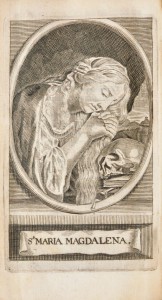 Bless me father, for I have sinned… So began the Catholic sacrament of confession as I remember it from thirty years ago, having made my ‘first confession’ at the Church of St Hugh’s, Buckden (Cambridgeshire) in the late 1970s. At least twice a year my siblings and I would wait uneasily in the pews at the back of church preparing for five minutes of toe-curling embarrassment with one of the parish priests as we stumbled through our short list of pre-adolescent failings: disobedience, showing disrespect to our elders, laziness, lying, cheating, sometimes stealing.
Bless me father, for I have sinned… So began the Catholic sacrament of confession as I remember it from thirty years ago, having made my ‘first confession’ at the Church of St Hugh’s, Buckden (Cambridgeshire) in the late 1970s. At least twice a year my siblings and I would wait uneasily in the pews at the back of church preparing for five minutes of toe-curling embarrassment with one of the parish priests as we stumbled through our short list of pre-adolescent failings: disobedience, showing disrespect to our elders, laziness, lying, cheating, sometimes stealing.
It’s arguable how beneficial all this was for the juvenile mind, and perhaps that’s beside the present point. I was glad however when in the 1980s individual confession came to be replaced by services of ‘general absolution’. These meant you didn’t have to name your sins out loud, which was probably for the best as we passed through our teens. In truth, one-to-one confession wasn’t as bad as it sounds and was approached seriously in our family, albeit with a certain grim humour. 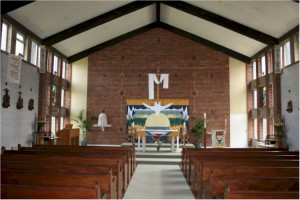 The ‘confessional’ in 1950s-built St Hugh’s was nothing like the comedy baroque chambers you see in the films—it was more like a well-maintained public convenience. If you were lucky, it would be Father Rourke behind the curtain, who was rather deaf and whose gentle Irish accent was so impenetrable that you couldn’t be upset by his response. He would listen to your confession and then invite you to consider ‘crushing the head of the serpent’, sending you away to recite three Hail Marys or an Act of Contrition.
The ‘confessional’ in 1950s-built St Hugh’s was nothing like the comedy baroque chambers you see in the films—it was more like a well-maintained public convenience. If you were lucky, it would be Father Rourke behind the curtain, who was rather deaf and whose gentle Irish accent was so impenetrable that you couldn’t be upset by his response. He would listen to your confession and then invite you to consider ‘crushing the head of the serpent’, sending you away to recite three Hail Marys or an Act of Contrition.
The challenge for us children was to come up with a sensible and credible list of sins, usually confined to the basics—non-controversial but without sounding as though you were reading from the same list every time. A story told by our grandmother warned us of the dangers of anything too outré—as a convent-girl in the 1920s she had confessed to adultery and it had caused a stir. Invited by her confessor to elaborate she explained that she had been seen wearing an under-vest in public and that, even worse, she had borrowed it without permission from another girl.
A brilliant solution was devised by our little sister in the form of a tiny, clandestine manuscript scarcely bigger than a communion wafer. It consisted of a few stapled pages on which were written, in minute script, a goodly range of childish sins. The manuscript could be concealed in the palm of the hand and served as a peccatorial aide-memoire once in the confessional; if you opened the pages at random, the laws of chance took care that sins would be rehearsed in a different sequence every time. For a consideration, our sister would lend it to her brothers, and so the little book would be passed along the pew and then put away, concealed in a sock drawer, until the next time. Bless me father, for I have sinned…
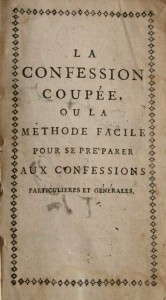 However, I realise we were not the first to come up with this solution. In fact, in the seventeenth-century cleric Christophe Leuterbreuver, had published a remarkable little pocket book along this line which became a bestseller, running to numerous editions. It was more than just a list though—being a fully-fledged livre à système incorporating hundreds of folding slips. I have now owned several copies of this book, the earliest being printed in 1695 the latest in 1751.
However, I realise we were not the first to come up with this solution. In fact, in the seventeenth-century cleric Christophe Leuterbreuver, had published a remarkable little pocket book along this line which became a bestseller, running to numerous editions. It was more than just a list though—being a fully-fledged livre à système incorporating hundreds of folding slips. I have now owned several copies of this book, the earliest being printed in 1695 the latest in 1751.
Designed as a practical aid to the sacrament of confession Leuterbreuver’s ingenious little work first appeared in 1677 and ran to many editions. Intended as a complete manual of confession, the moveable slips provided a solution to the problem of making a full and detailed confession from memory. 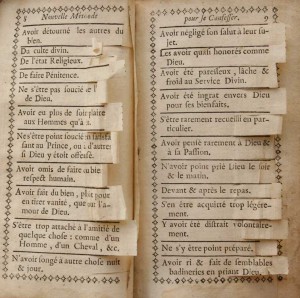 The sinner can mark the entries relevant to him or her by lifting the corresponding printed slips and then replacing them later so that no-one need ever know what was confessed. In reality, the lifted slips were often folded to mark them more clearly and it is, of course, intriguing to see which of the hundreds of sins have been marked. In the copy I have on my desk now very few of the slips are folded, but the one printed: ‘I have often had the name of the devil in my mouth’ is very clearly marked.
The sinner can mark the entries relevant to him or her by lifting the corresponding printed slips and then replacing them later so that no-one need ever know what was confessed. In reality, the lifted slips were often folded to mark them more clearly and it is, of course, intriguing to see which of the hundreds of sins have been marked. In the copy I have on my desk now very few of the slips are folded, but the one printed: ‘I have often had the name of the devil in my mouth’ is very clearly marked.
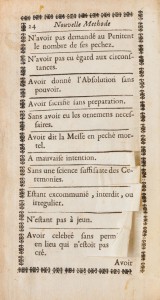 The book as a whole provides an uncommonly intimate view of the soul, akin to listing at the door of the confessional. The sins are set out according to the Ten Commandments and provide a glittering array of human failings. This is not a book for children and one wonders whether its popularity was as much because it provided such a panorama of the dark side of the soul. The list of sins for the ninth commandment, for example includes memoranda for ‘Avoir eu des pensées & des désirs lascifs. Y avoir eu de la délectation… Avoir prêté consentement aux illusions nocturnes… Avoit employé l’art magique des breuvages, & choses semblables, pour engager quelque personne en amour… Avoir dit des chansons lascives. Avoir dit les contes, & tenu des entretiens lascifs. Avoir fait des billets & écrits lascifs. Avoir eu, lû, & donné les Livres lascifs… Avoir jetté des regards déshonnêtes…’
The book as a whole provides an uncommonly intimate view of the soul, akin to listing at the door of the confessional. The sins are set out according to the Ten Commandments and provide a glittering array of human failings. This is not a book for children and one wonders whether its popularity was as much because it provided such a panorama of the dark side of the soul. The list of sins for the ninth commandment, for example includes memoranda for ‘Avoir eu des pensées & des désirs lascifs. Y avoir eu de la délectation… Avoir prêté consentement aux illusions nocturnes… Avoit employé l’art magique des breuvages, & choses semblables, pour engager quelque personne en amour… Avoir dit des chansons lascives. Avoir dit les contes, & tenu des entretiens lascifs. Avoir fait des billets & écrits lascifs. Avoir eu, lû, & donné les Livres lascifs… Avoir jetté des regards déshonnêtes…’
My grandmother’s confessors might have blanched at the sight of it, but she herself would have been intrigued and perhaps just a little amused. And I hope Father Rourke will forgive me for writing this post.
